Project Plan Template and guide notes
Project Plan Template and guide notes
Project Plan Template and guide notes
Create successful ePaper yourself
Turn your PDF publications into a flip-book with our unique Google optimized e-Paper software.
<strong>Project</strong> <strong>Plan</strong><br />
Team/Specialty Completed by Date<br />
1) <strong>Project</strong> Title<br />
2) <strong>Project</strong> Background<br />
3) <strong>Project</strong> Objectives<br />
4) <strong>Project</strong> Scope <strong>and</strong> Exclusions<br />
5) <strong>Project</strong> Team<br />
6) Outline Proposal<br />
7) Process <strong>and</strong> Methodology
8) Risks <strong>and</strong> Contingencies<br />
9) Baseline Evaluation<br />
10) Data Requirements <strong>and</strong> Metrics<br />
11) Communication <strong>Plan</strong><br />
12) Outcome Assessment<br />
13) Reporting<br />
14) Support <strong>and</strong> Resource Implications<br />
15) Sustainability <strong>and</strong> Spread
<strong>Project</strong> <strong>Plan</strong><br />
The project plan shows at high level how <strong>and</strong> when the project’s objectives are to be<br />
achieved. It sets out the various actions that must be undertaken to achieve the objectives<br />
together with timescales, responsibilities <strong>and</strong> resources required.<br />
<strong>Project</strong> Title<br />
Define the main title of the project<br />
<strong>Project</strong> background<br />
You may wish to include the reasons why the project is being undertaken, how it fits with<br />
local <strong>and</strong> national priorities <strong>and</strong> some local demographic data alongside some national data.<br />
What is the current state of your service <strong>and</strong> why does it need to change?<br />
<strong>Project</strong> objectives<br />
Define the main aims <strong>and</strong> objectives of the project – what do you aspire to achieve with this<br />
piece of work? Be brief <strong>and</strong> clear. Don’t use technical jargon or acronyms <strong>and</strong> remember<br />
that the objectives within the project aims will need to be agreed with all stakeholders.<br />
<strong>Project</strong> scope<br />
Define what the scope of the project is <strong>and</strong> what is excluded. It is important to define where<br />
the project begins <strong>and</strong> ends <strong>and</strong> help prevent ‘project creep’ in the future – other areas of<br />
work may be identified as different future projects<br />
<strong>Project</strong> Team<br />
Identify who the members of the project steering group are, who is leading <strong>and</strong> sponsoring<br />
the project, <strong>and</strong> who are the wider stakeholders involved in this work? Include their names,<br />
job titles, role within the project, email addresses <strong>and</strong> contact numbers.<br />
Outline Proposal<br />
Describe what work you are proposing to do as part of the project. What are the project<br />
prerequisites - what needs to be in place at the project start <strong>and</strong> maintained throughout i.e.<br />
trained staff, equipment etc. Consider the external dependencies that are beyond the direct<br />
control of the project manager but crucial to the success of the project. What are the<br />
deliverables <strong>and</strong> expected changes as a result of this project i.e. what will be the added<br />
value that this project will deliver? What are the timeframes <strong>and</strong> milestones?<br />
Process <strong>and</strong> Methodology<br />
Briefly describe the process by which this project will be undertaken – how do you propose<br />
to do the work? This could include process mapping the whole pathway of care to<br />
underst<strong>and</strong> the current flow of patients <strong>and</strong> bottlenecks, or defining a data collection plan in<br />
order to analyse the steps within the pathway. How are you going to do it?<br />
Risks <strong>and</strong> Contingencies<br />
Describe the potential risks <strong>and</strong> constraints of the project <strong>and</strong> the contingencies you propose<br />
to overcome these – try to manage expectations here i.e. timeframes <strong>and</strong> resource<br />
requirements. Identify what could impact on the success of the projects completion <strong>and</strong> the<br />
actions the project team have agreed to take to minimise these risks. Some elements will<br />
clearly beyond the control of the project, but describe how these have been acknowledged.
Baseline Evaluation<br />
Detail your baseline evaluation of the current service provision using data <strong>and</strong> information<br />
you have obtained as part of the ‘work before the work’. This is your starting point <strong>and</strong> a key<br />
part of any future measurement of project success.<br />
Data Requirements <strong>and</strong> Metrics<br />
Detail the data requirements for the projects <strong>and</strong> identify the source of the data required. The<br />
project team will need to spend some time thinking about the metrics that will be used to<br />
measure the on-going success of the project <strong>and</strong> then determine where the relevant data<br />
can be found. This may be readily available <strong>and</strong> automated or may require manual data<br />
collection. It may be work devising a data collection plan that clearly illustrates these once<br />
the metrics have been decided. The team will also need to determine the definition of each<br />
metric used <strong>and</strong> the frequency of data collection in order to maintain consistency throughout<br />
the project <strong>and</strong> beyond.<br />
Communication <strong>Plan</strong><br />
Detail how the overall communication will be managed within the project team <strong>and</strong> wider<br />
stakeholder groups <strong>and</strong> identify who will be responsible for this. Detail the recipients of<br />
minutes, reports <strong>and</strong> format of reports at both local <strong>and</strong> national level. Determine the<br />
frequency of meetings, chair, members to attend <strong>and</strong> agree on future meeting dates. Also<br />
identify how the project may interface with other programmes of work, either nationally or<br />
locally<br />
Outcome Assessment<br />
Identify what outcomes the project is likely to deliver – what will these look like <strong>and</strong> how will<br />
you know they have been achieved? Also include quality expectations here in terms of the<br />
expectations of quality assurance, review <strong>and</strong> control of the project <strong>and</strong> its outputs <strong>and</strong><br />
outcomes. Identify who will be responsible for quality assurance <strong>and</strong> how this will be<br />
reported<br />
Reporting<br />
Identify how <strong>and</strong> when reports will be generated <strong>and</strong> where they will be reported into. In this<br />
section, name the person who will be responsible for the reports.<br />
Support <strong>and</strong> Resource Implications<br />
Detail the support <strong>and</strong> resource requirements of the project with ball-park costs. This may<br />
include equipment <strong>and</strong> people, <strong>and</strong> details of agreements for core project team members<br />
release to work on the project or attend project meetings.<br />
Sustainability <strong>and</strong> Spread<br />
Describe how it is envisaged that any improvement or redesign work will be sustainable over<br />
the long term. Detail any additional risks <strong>and</strong> contingencies that will need to be managed,<br />
plus any on-going data collection <strong>and</strong> analysis. Also describe the process by which the<br />
learning from the project can be shared <strong>and</strong> spread to other areas both local <strong>and</strong> regional<br />
level. Consider what products will best achieve this shared learning i.e. publications,<br />
presentations or peer support groups.


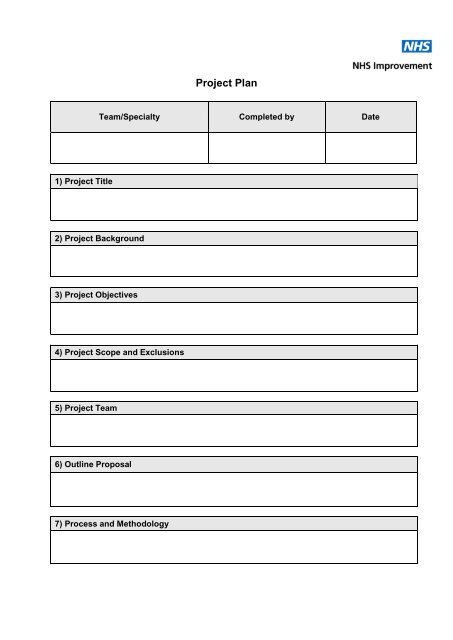
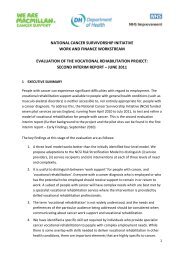


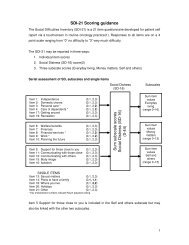

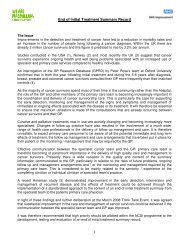
![Download the how to guide [PDF] - Macmillan Cancer Support](https://img.yumpu.com/47067428/1/184x260/download-the-how-to-guide-pdf-macmillan-cancer-support.jpg?quality=85)
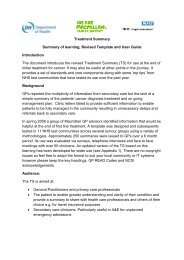


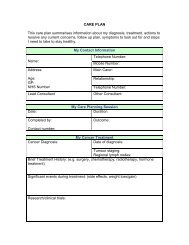

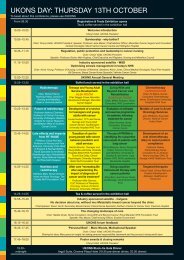

![HOPE Protocol [PDF, 420KB] - National Cancer Survivorship Initiative](https://img.yumpu.com/32566432/1/184x260/hope-protocol-pdf-420kb-national-cancer-survivorship-initiative.jpg?quality=85)